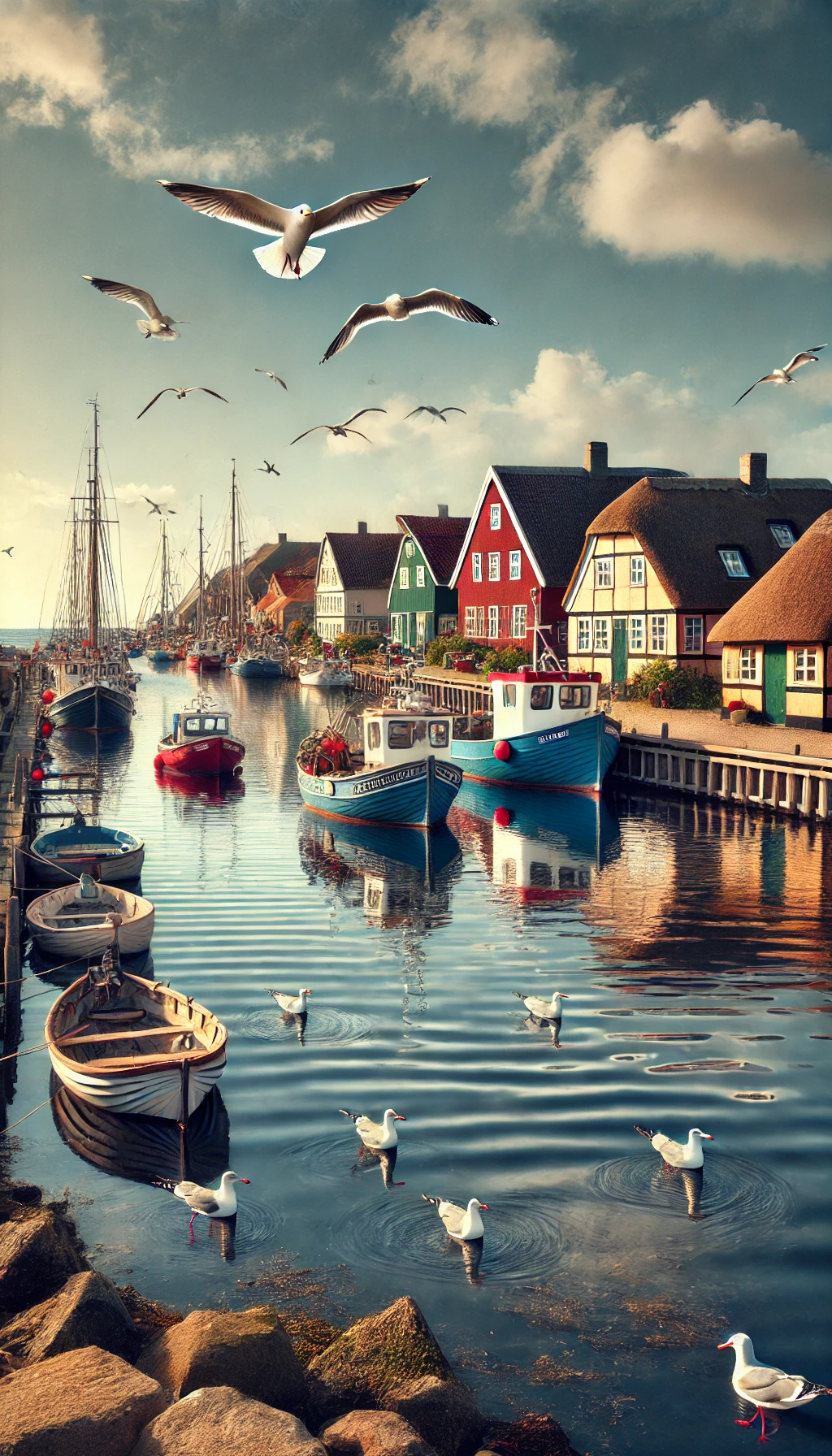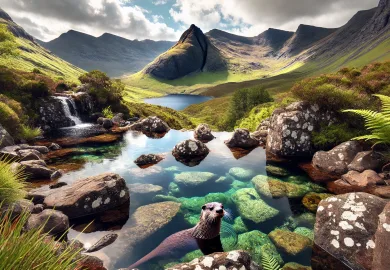
Denmark, a country known for its rich Viking history, scenic landscapes, and vibrant cities, is often visited for its famous sites like Copenhagen’s Nyhavn or the Tivoli Gardens. However, beyond these well-trodden paths lie hidden gems waiting to be explored by those seeking less conventional, more authentic experiences. In this guide, we will take you on a journey to Denmark’s lesser-known travel destinations and secret hideaways where nature, history, and culture intertwine to offer unique adventures.
Møns Klint: The White Cliffs You Haven’t Seen
Møns Klint is one of Denmark’s most dramatic natural landmarks, yet it remains relatively under the radar for many tourists. Located on the island of Møn, these chalk-white cliffs stand majestically against the turquoise waters of the Baltic Sea, providing a striking contrast that is awe-inspiring. The cliffs stretch over six kilometers and rise up to 128 meters, offering stunning panoramic views.
Visitors to Møns Klint can enjoy more than just breathtaking views. The area is also home to lush beech forests, where you can explore walking and cycling trails, or even fossil hunting along the beach below. The cliffs are particularly famous for their fossil-rich chalk deposits, making it a popular spot for those interested in geology and natural history. Bird watchers will also find delight in spotting rare bird species that inhabit the area, such as the peregrine falcon.
Despite its beauty, Møns Klint remains a quieter destination compared to other natural sites in Denmark, making it a perfect retreat for those seeking solitude in nature. The Møns Klint Geocenter also offers educational insights into the history and formation of the cliffs, further enriching your visit.
Ærø: A Fairytale Island in the South Funen Archipelago
Tucked away in the South Funen Archipelago is the small island of Ærø, a destination that feels like stepping into a fairytale. Ærø is dotted with charming villages, cobblestone streets, and colorful half-timbered houses, offering a nostalgic glimpse into Denmark’s pastoral past. While Ærø may not be on the main tourist track, it’s the perfect place to relax and enjoy authentic Danish island life.
The island’s main town, Ærøskøbing, is often referred to as “Denmark’s best-preserved 18th-century village.” Here, you’ll find picturesque houses with blooming flower boxes, tiny boutiques selling local handicrafts, and inviting cafés. Ærø is also a popular destination for cyclists, with its rolling hills and coastal paths offering scenic routes along the island’s perimeter.
For those who love the sea, Ærø offers plenty of opportunities to enjoy the water. You can sail along the coastline, kayak through calm bays, or simply relax on the island’s peaceful beaches. Marstal, another town on the island, has a rich maritime history and offers insights into Denmark’s naval past through the Marstal Maritime Museum.
Rold Skov: Denmark’s Enchanting Forest Wonderland
Rold Skov is Denmark’s largest forest and one of its best-kept secrets. Located in North Jutland, this expansive forest covers over 8,000 hectares and is a paradise for nature lovers. The forest’s diverse landscape includes everything from dense woodlands to open meadows and serene lakes, providing a peaceful escape from the hustle and bustle of city life.

Visitors to Rold Skov can explore a variety of walking, biking, and horse-riding trails that wind through the forest. The Troldeskoven (Troll Forest) is particularly enchanting, with its twisted, gnarled trees that seem to come straight out of a fantasy novel. Legends of trolls and forest spirits have long been associated with this area, adding a mystical charm to the experience.
Rold Skov is also home to Denmark’s most famous natural spring, Rebild Bakker, where crystal-clear water flows from the forest into the surrounding countryside. The forest is rich in wildlife, and visitors might catch a glimpse of deer, foxes, and various bird species. Whether you’re a hiker, a cyclist, or simply someone who enjoys being immersed in nature, Rold Skov offers an unforgettable adventure.
Samsø: Denmark’s Green Energy Island
Samsø is not only a hidden gem but also a remarkable success story in sustainability. This small island in the Kattegat Sea has become world-famous for its commitment to renewable energy and sustainable living, but it still remains an off-the-beaten-path destination for many travelers. Samsø achieved energy self-sufficiency in the early 2000s, with the entire island now powered by wind, solar, and biomass energy.

Beyond its environmental achievements, Samsø offers a picturesque rural landscape with golden fields, rolling hills, and quaint villages. The island is perfect for cycling enthusiasts, with scenic bike routes crisscrossing its countryside. Samsø is also home to stunning beaches and crystal-clear waters, ideal for swimming, sailing, and windsurfing.
If you visit in late summer, you can enjoy the Samsø Festival, a family-friendly music event that attracts visitors from all over Denmark. Local produce is also a highlight, as the island is known for its high-quality fruits, vegetables, and dairy products. A visit to one of the local farm shops or enjoying a meal at a farm-to-table restaurant is a must for any food lover.
Kalø Castle Ruins: A Medieval Adventure Near Aarhus
For history enthusiasts, the Kalø Castle Ruins offer a unique and hidden historical site just a short drive from Denmark’s second-largest city, Aarhus. Located on a small peninsula jutting into Kalø Vig, the castle was built in 1313 by King Erik Menved as a fortress to control rebellious nobles. Though the castle was abandoned and fell into ruins in the 17th century, it remains a fascinating destination for anyone interested in medieval history.

The walk to Kalø Castle is an experience in itself. A cobbled causeway leads visitors across the water to the ruins, offering breathtaking views of the surrounding fjord and countryside. Once you reach the ruins, you can explore the remains of the castle’s walls, towers, and dungeons while imagining what life was like in medieval Denmark.
Kalø is also a popular spot for picnicking and bird-watching, with its scenic surroundings providing a peaceful setting for a day trip. The area around the castle is part of the Mols Bjerge National Park, which offers additional hiking and nature experiences for those looking to extend their visit.
Fur Island: Denmark’s Fossil Paradise
If you’re fascinated by geology and fossils, Fur Island is a hidden treasure you won’t want to miss. Located in the Limfjord, Fur is renowned for its unique geological formations and an abundance of well-preserved fossils dating back millions of years. The island’s cliffs are made up of volcanic ash layers interspersed with clay, creating a striking natural landscape.
Fossil hunting on Fur is a popular activity, and you don’t need to be an expert to find ancient treasures here. Many visitors have found fossilized fish, plants, and insects from the Eocene Epoch while exploring the island’s beaches. The Fur Museum offers insight into the island’s geological history and displays many of the remarkable fossils found in the area.
Fur is not just about fossils; the island also offers charming villages, scenic coastal views, and plenty of opportunities for hiking and cycling. With its rich natural beauty and quiet atmosphere, Fur provides a peaceful escape from Denmark’s more crowded tourist destinations.
Fanø: A Slice of Danish Coastal Paradise
Fanø, located in the North Sea just off the coast of Esbjerg, is a hidden island paradise offering endless beaches, quaint villages, and a rich maritime heritage. Despite its proximity to the mainland, Fanø has retained its unique charm and remains a quiet destination, perfect for those looking to experience authentic Danish coastal life.
The island’s main village, Nordby, is a delightful maze of narrow streets and well-preserved 18th-century houses, while Sønderho, located at the southern tip of the island, has been named Denmark’s most beautiful village. Fanø’s wide, sandy beaches are ideal for kite flying, beachcombing, and windsurfing. The island is also home to a variety of wildlife, including seals, which can often be spotted lounging on the sandbanks.
Fanø’s unique cultural heritage is celebrated through various festivals and traditions, including the Fanø International Kite Festival, which attracts kite enthusiasts from around the world. Whether you’re interested in outdoor activities or simply soaking up the island’s laid-back atmosphere, Fanø is a must-visit for those seeking an off-the-beaten-path destination in Denmark.
Conclusion
Denmark’s hidden travel destinations offer an array of unique experiences that go beyond the usual tourist trail. From the dramatic cliffs of Møns Klint to the charming fairytale island of Ærø, these secret spots allow visitors to experience the true essence of Denmark—its natural beauty, rich history, and sustainable living. Whether you’re a history buff, a nature lover, or someone looking to relax away from the crowds, these hidden gems provide the perfect opportunity to explore a different side of Denmark.
By stepping off the beaten path, you’ll discover that Denmark has much more to offer than meets the eye, and these hidden treasures are just waiting to be uncovered.








